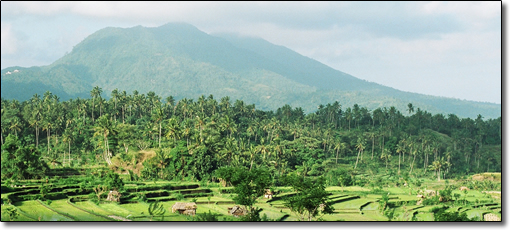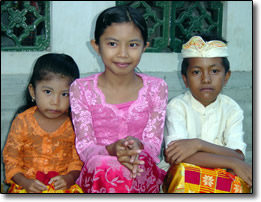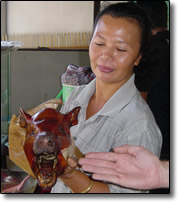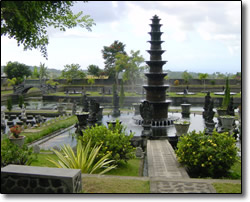
Around Semarapura
After a few days in Ubud to enjoy the shops, culture and food, we rented a motorbike for a drive through the countryside to see some other parts of Bali. We stuck to smaller roads, as much to avoid the weaving cars, trucks and motorcycles as to escape the exhaust fumes. A roadside stall served “babi guling”, roast suckling pig. The tender meat is finely minced with spices and served with rice and vegetables. Semarapura (formerly known as Klungkung) is the site of a famous “puputan”, or mass suicide, committed by the Balinese in 1908 when the Dutch invaded the town. Graphically depicted in the climax of Vicki Baum’s classic “Liebe und Tod auf Bali”, the town was so stigmatized that later the name was changed. Near Semarapura are Gamelan factories. We stopped at one to see the process of making gongs, but it was a holiday and there were only a few xylophone bars being polished. Apparently, the large gongs that we had hoped to see were made elsewhere. North of town the road winds through a wide valley of glistening rice fields, with Gunung Agung, Bali’s temperamental volcano and Mt. Olympus, towering overhead. Along the side of the road were salak, or snakefruit plantations. Sweet and slightly bitter, with large, brown seeds and a peel that looks like the skin of a snake, salak grows in clusters at the base of thorny, palm-like trees. We had tried salak last year in Lombok and didn’t care for it, but after tasting the sweet Bali variety, renowned throughout Indonesia as the best, we were hooked. We stopped to buy some directly from a roadside warehouse.
 |
 |
Tirta Ganga (“waters of the Ganges”) is the site of a water palace built by a former Rajah. We stayed here for several nights, touring the surrounding area during the day. From the heights of Pura Pasaran Agung, a temple halfway up Mt. Agung, we could admire the fine views of the island. The 3000m summit of the volcano did not look far away. One of the four “directional” temples, Pura Lempuyang, was on a mountaintop nearby. The Balinese do not use north, south, east and west, but instead have different set of directions, anchored by four holy sites. Pilgrims from all over the island come to pray and leave offerings at the site. The local band of monkeys watch from the sidelines, jumping on the offerings of fresh fruit and vegetables placed reverently on the altars.
 |
 |
